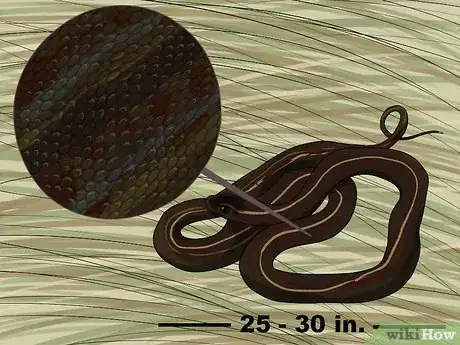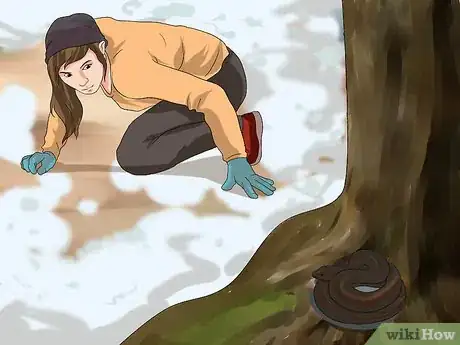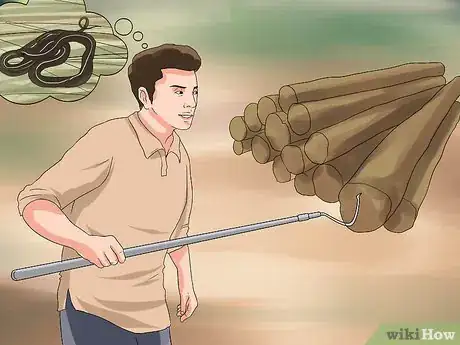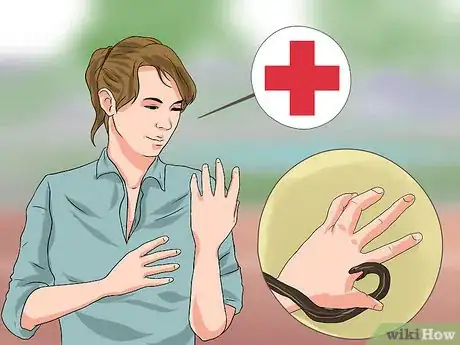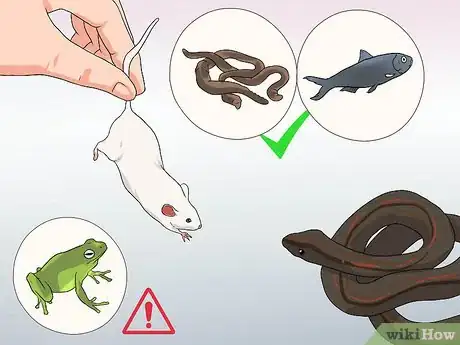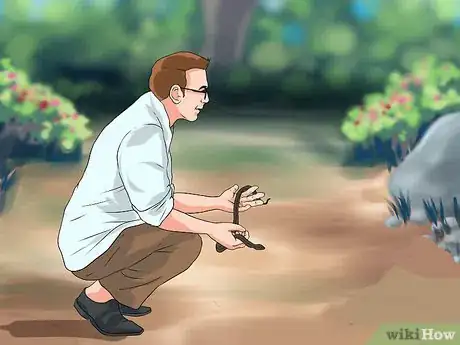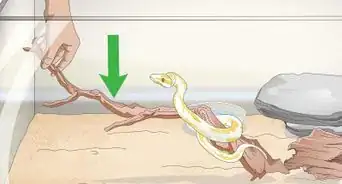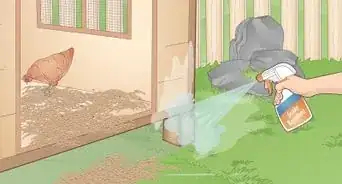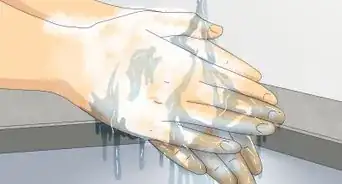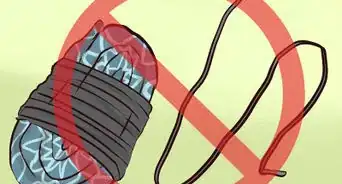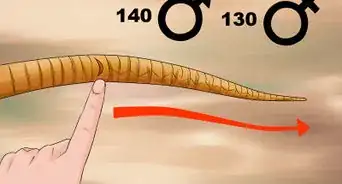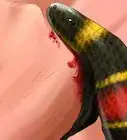This article was co-authored by Jeff Jensen. Jeff Jensen is a Reptile Specialist and the Owner of The Reptile Zone out of Bend, Oregon. With decades of experience with reptiles and wildlife, Jeff specializes in providing advice and guidance on proper reptile care. As a former science teacher and employee of the San Antonio Zoo and an accomplished herpetologist, Jeff’s dedication to knowledge and ethical pet trade practices led to The Reptile Zone being awarded a “Mark of Excellence” Award by Intrepid Marketing in 2018.
There are 10 references cited in this article, which can be found at the bottom of the page.
wikiHow marks an article as reader-approved once it receives enough positive feedback. In this case, 100% of readers who voted found the article helpful, earning it our reader-approved status.
This article has been viewed 129,219 times.
Garter snakes, also known as garden snakes or Gardner snakes, are common across North America from Canada to Florida. They are the single most widely distributed genus of reptile in North America, and are a common sight in American gardens. Since they are not venomous to humans, many people keep them as pets. Finding a garter snake means searching for a garter snake, catching it, and caring for it if you want to keep it as a pet. Gartner snakes can be a fun and safe pet to keep if you want a snake, but don’t want to be in the danger of having a venomous snake as a pet.
Steps
Searching for Garter Snakes
-
1Identify garter snakes by their markings. Garter snakes are known for their unique stripe pattern. Make sure you know what a garter snake looks like so you don’t accidentally encounter a deadly snake.[1]
- Garter snakes come in many different colors. They often blend into their environment, but can be red, green, black, yellow, or many other colors.
- These snakes can be best identified by three long stripes down their body. One stripe goes down the center of the back, while two others are on the side of their body. However, some garter snakes have no stripes, so pay attention to the specific species in your area.
- Garter snakes are usually between 25 and 30 inches, but some can grow as long as 5 feet. They can also be lean or stout in appearance.
- If you’re not sure if a snake is a garter or not, avoid it, especially if you live somewhere with venomous snakes. You don’t want to be accidentally bitten by a dangerous snake.
-
2Search for garter snakes during the heat of the day. They are cold-blooded creatures, so they are not likely to be visible during the evening. However, during the day they will bask in the sun to regulate their body temperature.[2]
- March to April is the most likely time to catch your first sighting of a garter snake. They usually will not emerge earlier so they can avoid a late frost.
- In early spring, garter snakes only emerge very briefly from hibernation. It may be harder to find them, since they don’t leave very often or for very long periods of time.
- Garter snakes bask during the day, which means they find a location to soak up the sun. These locations are also likely to have a place where garter snakes can quickly hide like rocks, bushes, or animal burrows.
- When it's cooler outside, such as the early morning or early evening, garter snakes will likely be searching for prey. During these times, you won't find them exposed in the open, so they may be harder to find.[3]
Advertisement -
3Look for snakes near their food sources. If you live near water, you may find garter snakes nearby if they eat fish. However, if you do not live near water, garter snakes are more likely found in areas where amphibians and earthworms are likely to be.
- Garter snakes eat fish as one of their primary food sources. Look for them near water, especially during times when fish are highly visible in your area.
- Amphibians are also a food source for garter snakes. They eat animals like small frogs or toads. These should be especially visible after it rains.
- Garter snakes also eat earthworms. Look for them in areas with a lot of dirt and soil.
-
4Look for snakes in their hiding places. Gartner snakes hibernate during the winter months. When not hibernating, look for snakes to live in dark, secluded areas during the evening and out in the sun during the day.
- During hibernation, garter snakes occupy large, communal sites called hibernacula. These areas will likely be secluded spots that stay relatively warm during the cold winter months.
- Most garter snakes hide or live in dark places during the spring and summer when they are not basking.
- Check for garter snakes in fields, tall grass, under leaves, and logs. They prefer to be close to the ground and camouflaged in the grass.
- During the winter, you may also find garter snakes holed up in your basement or attic. If this is the case, you can either keep it until the spring or dispose of the garter snake outside, which will likely kill it.[4]
Catching a Garter Snake
-
1Hunt carefully for a garter snake. Looking for one can be a fun activity. It’s important to be careful when looking for one, since you can easily step on or run over garter snakes.
- Search in the primary habitats of garter snakes. Keep an eye out for hidden garter snakes underneath logs or behind bushes.
- Walk slowly and carefully in the grass or other environments. Consider wearing light shoes, since garter snakes can feel vibrations in the ground.
- Look for any movement in the grass or other garter snake environments. They move quickly, but you may be able to spot them through close observation.
- Watch for any sunny areas. Garter snakes need to bask in the sun during the day, so you may be able to find them there.
- Be careful not to step on a garter snake. It may injure them, but it will almost certainly frighten then enough to run away or bite you.
- If you’re on a bike, be careful not to run over garter snakes. They can easily get trapped in the spokes of your bike's wheel.
-
2Pick up the snake gently. After you locate a garter snake, be very careful and gentle when you pick it up. Try not to restrict the garter snake, so it will get frightened and potentially bite you.[5]
- Always try to approach a snake from the rear picking it up first from the backside and sliding your hand up to the front.
- Use a net or forked stick to capture the garter snake. You can trap them underneath until they finish thrashing and are subdued.[6]
- Try catching a garter snake by the tip of its tail. This may be harder, since they can slip out of your hands, but it’s possible to catch a garter snake by hand.
- Give garter snakes plenty of support. They may slide or crawl over your hands, but may also fall. Be careful to not drop them or let them slip out of your hands.
- Don’t restrict garter snakes’ movement. They will get frightened if they feel restricted in movement by you handling them.
- Garter snakes may musk on you. This is a bad smelling fluid that comes out of their vent. It’s harmless, so simply wash it off.
-
3Handle being bitten by garter snakes. Garter snake bites are not dangerous, though they can hurt and be unpleasant. If you are bitten, stay calm and maintain a grip on the garter snake.[7]
- Though they are unlikely to bite, it may occasionally happen if they are frightened. If the snake does bite, stay calm and handle the snake carefully.
- Since garter snakes are trying to escape, they do not usually hang on to the bitten area. They will try to strike and escape after biting.
- Some garter snakes may be hungry and hang onto the bitten area. If they do, gently push its head forward to remove its teeth from where it has bitten you.
- The best way to avoid being bitten by garter snakes is to avoid handling them. Garter snakes do not seek out humans, so if you stay away from them they will not bite you.
-
4Get medical attention if you get bitten. Even though garter snakes are not venomous, care for your snake bite wound the way you would any other injury. If it becomes infected, go see a doctor immediately.
- Garter snakes have fangs in the back of their mouths that produce small amounts of a mild neurotoxic venom. It is not dangerous to humans though.
- Make sure to clean out the wound thoroughly if you are bitten to avoid it becoming infected. You should clean it and bandage it the same as you would any other wound.
- Some people react to snake saliva. This usually happens if the snake chews on your bitten area. If you notice the wound becoming infected, go see a doctor immediately.[8]
Caring for a Garter Snake
-
1Make an appropriate habitat for your garter snake. If you want to keep a garter snake as a pet, make sure you have a cage that is the best size for the snake and has a place for the garter snake to hide.[9]
- Perform research and find out the requirements and required humidity when setting up an appropriate habitat for your garter snake.
- Supply your garter snake with the right amount of space. A 5- to 25-gallon tank is appropriate, depending on the size of the snake. If there’s not enough space, the snake will not be able to exercise and be unhealthy. With too little space, the garter snake will feel exposed.
- Give your garter snake with a “hiding box”. A hiding box is a space where the garter snake can conceal itself. Consider putting in a plastic box or a hollow log for the snake to curl up into.
- Provide your snake with a water dish that is regularly refilled. This will give them water to drink as well as a way to stay cool.
- Keep your snake safe by making sure it cannot escape. Garter snakes are at risk in a home by other pets and humans. Also, a garter snake on the loose can frighten people who do not know if it’s a venomous snake or not.
-
2Feed your garter snake. These snakes eat a variety of food, but it’s important to provide your snake with a good diet. Ideally, give them mice, but fish and earthworm are also good food for garter snakes. Avoid frogs and toads, since they can cause dangerous infections for garter snakes in captivity.[10]
- Mice provide garter snakes with a balanced diet. Not all garter snakes eat mice, so make sure yours is one that does. Otherwise, you’ll have to keep in mind ways to balance the garter snake’s diet.
- Earthworms are a particularly good diet for younger garter snakes. Cut them into smaller pieces, so they are smaller than the garter snake. They may not be able to eat full-size earthworms when they are younger.
- Fish can also be used for garter snakes. Frozen fish is best, since parasites will not be a problem. Don’t give them fresh fish, since your garter snake may become infected.
- Avoid feeding your garter snakes frogs and toads. Though garter snakes eat frogs and toads in the wild, they are more resistant to the parasites in frogs and toads. Your pet garter snake will not be as resistant, so it’s best to avoid them entirely.
-
3Release your garter snake into the wild. Garter snakes may make fun pets, but it may also be best to release them back into the wild. Make sure to bring them back to where you found them, so they will have the best habitat to return to. Also, always release garter snakes back into the wild during the warmest months.[11]
- Some garter snakes may refuse to eat in captivity. If this is the case, release your garter snake as soon as possible so it does not starve to death.
- If the garter snake is not adjusting to captivity, release them within a week or two. Keeping a garter snake too long can reduce its chances of survive in the wild.
- Bring garter snakes back to where you found them. They can easily find their way back to their habitat. Returning them to a foreign environment may make them less likely to survive.
- Release garter snakes into the wild only during warmer months. Since they hibernate, garter snakes are not able to survive during the winter. Keep them in a warm, safe space until they are ready to come out of hibernation.
Community Q&A
-
QuestionWhat time of day should I look for a common garter snake?
 Community AnswerIt is probably best to find them in the afternoon when it is warm. You could also place a dark colored tarp in the sun somewhere where it's damp, and the garter snakes may come to lay and rest in the sun. It will be easier to catch them then.
Community AnswerIt is probably best to find them in the afternoon when it is warm. You could also place a dark colored tarp in the sun somewhere where it's damp, and the garter snakes may come to lay and rest in the sun. It will be easier to catch them then. -
QuestionHow long does a garter snake live?
 Community AnswerThe average lifespan of a garter snake in captivity is 6 - 10 years.
Community AnswerThe average lifespan of a garter snake in captivity is 6 - 10 years. -
QuestionWhere do I find them?
 Community AnswerThey live in the wild around North America as far as I know, but they may be around parts of Europe as well. I suggest doing some research into good habitats that they like to live in, and finding somewhere like that near you. Do a little searching, and you might find one! Be careful, though. Just because they aren't fanged doesn't mean a bite doesn't hurt, and even they can hurt you if scared enough. And make sure you don't hurt them, too! If you are going to pick it up, be very gentle, but also firm enough to keep them from getting away and falling out of your hand. Look up how to hold a snake behind the skull for reference beforehand.
Community AnswerThey live in the wild around North America as far as I know, but they may be around parts of Europe as well. I suggest doing some research into good habitats that they like to live in, and finding somewhere like that near you. Do a little searching, and you might find one! Be careful, though. Just because they aren't fanged doesn't mean a bite doesn't hurt, and even they can hurt you if scared enough. And make sure you don't hurt them, too! If you are going to pick it up, be very gentle, but also firm enough to keep them from getting away and falling out of your hand. Look up how to hold a snake behind the skull for reference beforehand.
References
- ↑ http://www.livescience.com/44072-garter-snake.html
- ↑ http://www.biokids.umich.edu/critters/Thamnophis_sirtalis/
- ↑ http://www.anapsid.org/gartcare.html
- ↑ http://www.gartersnake.info/articles/2008/garter-snakes-in-winter.php
- ↑ http://www.gartersnake.info/care/handling.php
- ↑ http://www.uvma.org/snakes/garter-snakes/catching-garter-snakes.htm
- ↑ http://www.gartersnake.info/care/handling.php
- ↑ http://www.gartersnake.info/care/handling.php
- ↑ http://www.gartersnake.info/care/housing.php
About This Article
If you want to find a garter snake, start by looking out for a snake with 3 stripes on its body, 1 down its back and 2 on its sides. Try to search for garter snakes during the day, because they'll bask in the sun to regulate their body temperature. Look in places close to water or where earthworms can be found, including under logs or behind bushes. Once you've found a snake, use a net to catch it or hold it by the tip of its tale. If the garter snake bites you, you should see a doctor if the bite gets infected. For tips on where to find a garter snake when its hibernating, read on!
